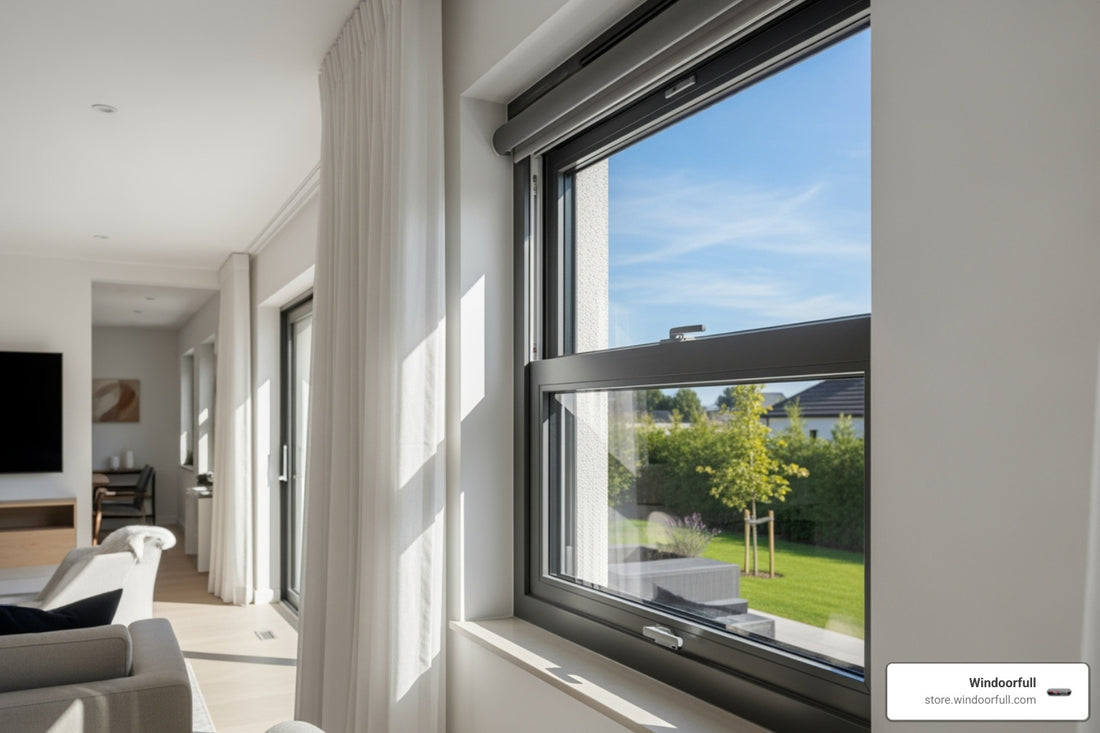
The Ultimate Guide to Tilt and Turn Windows
Share
Why Tilt and Turn Windows Are Revolutionizing American Home Design
Tilt and Turn Windows are European-style windows with a clever dual-action mechanism. A single handle allows them to either tilt inward from the top for secure, draft-free ventilation or turn fully inward like a door for maximum airflow and easy cleaning. This versatility is making them a popular choice for American homeowners seeking a modern, high-performance window solution.
Key features include:
- Dual-Action: Tilts for ventilation, turns for cleaning and egress.
- Single-Handle Control: Simple 90-degree rotations manage all functions.
- Energy Savings: Can reduce heating and cooling costs by up to 30%.
- Improved Security: Multi-point locking makes them 3x more secure than average windows.
- Durable Materials: Available in uPVC, aluminum, and wood with a 30-40 year lifespan.
These innovative windows solve common frustrations with traditional styles by offering precise airflow control, superior security, and effortless maintenance. Their ability to deliver energy efficiency, security, and modern aesthetics in one package is a testament to their ingenious European engineering.
I'm Wojciech Jagla from Windoorfull Imports Inc. We specialize in premium European-style windows, and I've seen how their superior performance and versatility transform American homes.
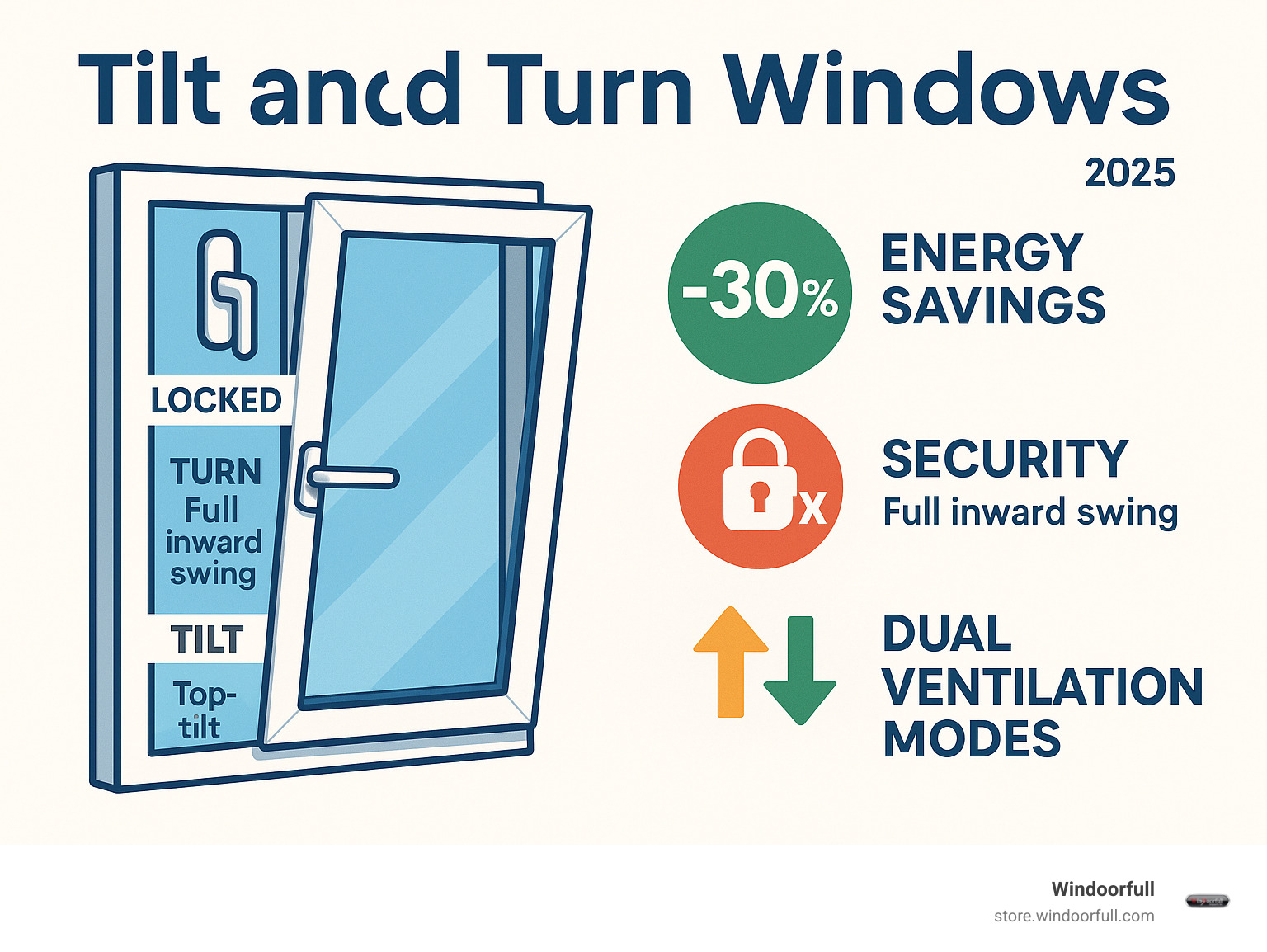
Terms related to Tilt and Turn Windows:
What Are Tilt and Turn Windows and How Do They Work?
At Windoorfull, we're often asked what makes Tilt and Turn Windows different. While they may resemble a modern casement window, their unique dual-action mechanism, a hallmark of European design, sets them apart.
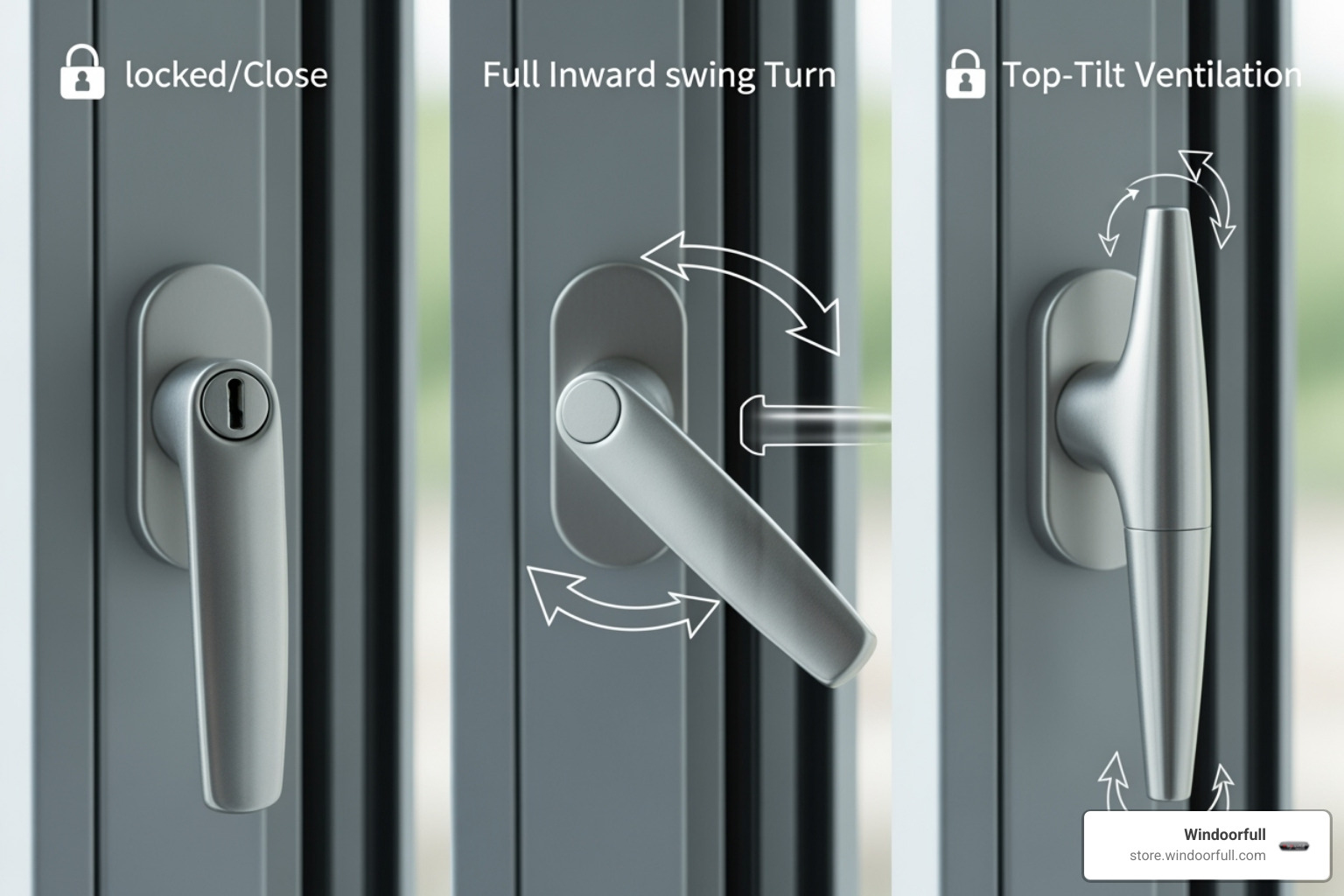
The magic is in the single, intuitive handle that controls three distinct positions: closed, tilted, or fully open. This smart design eliminates fumbling with multiple latches—a simple turn is all it takes.
The Ingenious Dual-Action Mechanism Explained
The window's unique hardware system enables two opening modes from one handle. Here’s how it works:
Locked Position: With the handle pointing down, the window is securely locked and sealed. This provides an airtight barrier against weather and noise, offering the clear, unobstructed view of a picture window with top-notch insulation.
Turn Function (Inward Swing): Rotate the handle 90 degrees to the horizontal position. This allows the entire window sash to swing inward like a door. This mode is perfect for maximum ventilation, provides an emergency exit route, and makes cleaning both sides of the glass from inside your home incredibly easy—a game-changer for upper floors.
Tilt Function (Top-Down Opening): Rotate the handle 180 degrees from the locked position (pointing up). The top of the sash tilts inward, creating a small gap for secure, draft-free ventilation. This allows stale air to escape at the top while fresh air flows in from the sides, making it ideal for continuous airflow, even during light rain.
This flexibility allows the windows to meet different needs with ease. Our article Beyond the Hinge: Everything You Need to Know About Tilt-Turn Windows explores this design further. For more on the components, see our guide on More info about tilt-turn window hardware from Windoorfull.
Key Benefits of the Tilt and Turn Design
The dual-action mechanism delivers several practical benefits:
Versatile Ventilation: Choose between a gentle, secure tilt for continuous, draft-free airflow or a full inward swing for maximum fresh air.
Improved Safety: The tilt position provides ventilation without the risk of accidental falls, making it ideal for homes with children or pets. It can also be key-operated for added control.
Easy Cleaning: The turn function allows you to safely clean both sides of the glass from inside your home, eliminating the need for ladders on upper-story windows.
Superior Security: Multi-point locking systems secure the sash to the frame at several points, making them incredibly difficult to force open. Our windows are designed to be 3x more secure than the average window.
Excellent Weatherproofing: A robust compression seal around the sash perimeter ensures superior air and water tightness, keeping out drafts, rain, and noise while boosting energy efficiency.
Unpacking Superior Performance: Energy Efficiency and Security
Tilt and Turn Windows deliver outstanding performance in energy efficiency and security. At Windoorfull, we see how these well-built windows make a real difference for homeowners.
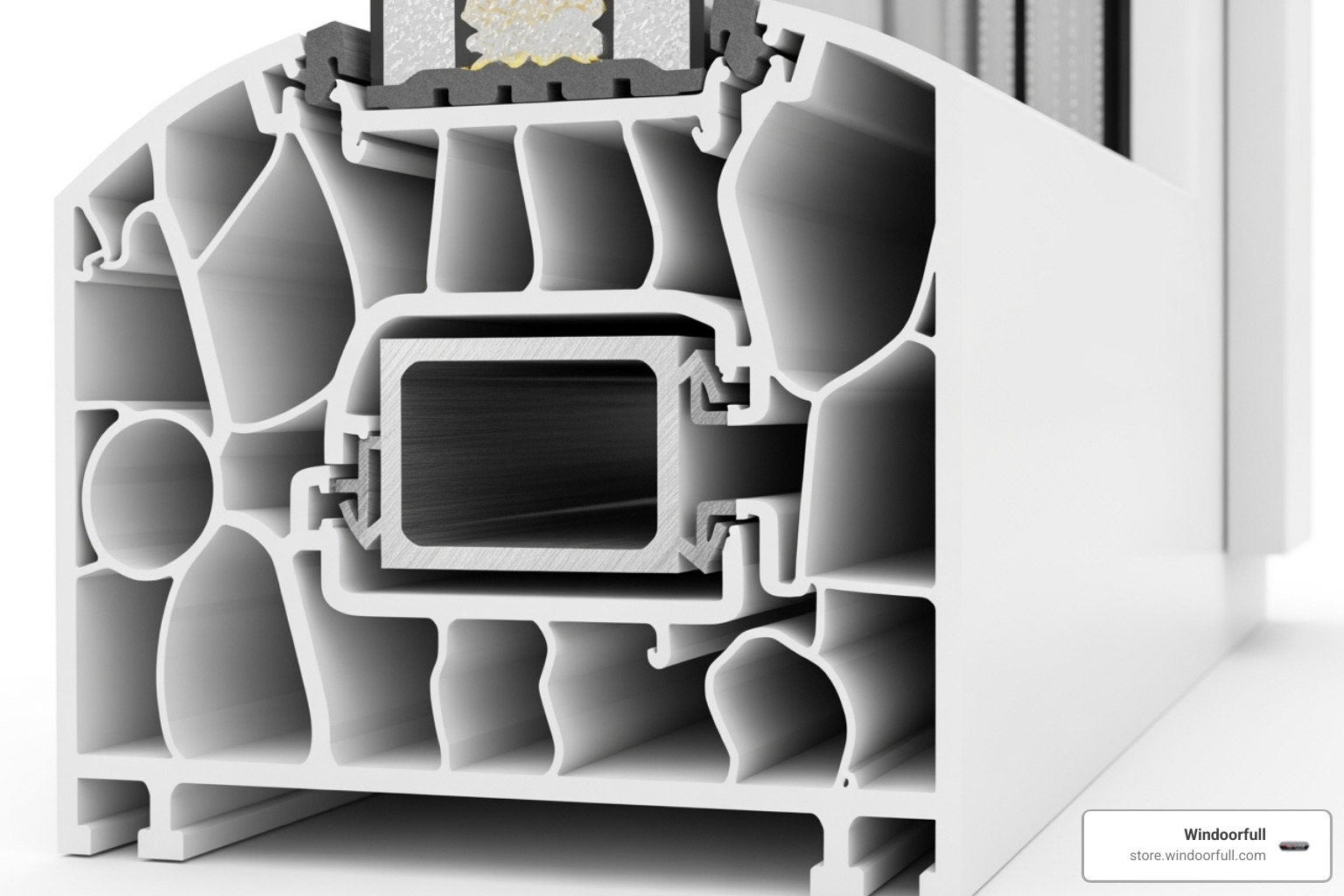
The secret is in the combination of steel-reinforced frames, multi-point locking systems, multi-chambered profiles, and advanced glazing. This engineering creates windows that are at least 50% more energy efficient than ENERGY STAR® certification standards require. They are also 80-100% more soundproof than typical windows, leading to a quieter, more comfortable home and saving you up to 30% on heating and cooling costs.
Maximizing Energy Efficiency with Tilt and Turn Windows
The exceptional energy performance of Tilt and Turn Windows comes from several layers of smart engineering:
- Glazing: Double-pane and triple-pane glazing create insulating air pockets that slow heat transfer. Triple-pane offers maximum insulation for extreme climates.
- Low-E Coatings: These microscopic layers reflect radiant heat, keeping your home cooler in the summer and warmer in the winter.
- Argon Gas Fill: Denser than air, this gas is used between panes to further slow heat transfer and boost thermal performance.
- Frames: Multi-chambered profiles with galvanized steel reinforcement prevent thermal bridging and provide structural strength.
This performance is measured by U-values, where lower numbers mean better insulation. Our windows achieve impressive U-values as low as 0.18 for Global70™ profiles and 0.14 for Global80™ profiles, representing top-tier insulating performance.
A Closer Look at Advanced Security Features
Security is integral to the design of Tilt and Turn Windows, making them 3 times more secure than average windows.
- Multi-Point Locking Hardware: Unlike typical windows with one or two locks, these engage multiple locking points around the entire sash, creating a barrier that's incredibly difficult to pry open.
- Glass Options: Laminated and tempered glass add another layer of security. Laminated glass is tough to break through, while tempered glass is stronger and crumbles safely if broken.
- Inward-Opening Design: This design prevents intruders from popping the sash out from the exterior. Even in tilt mode, the limited opening deters access.
- Steel Reinforcement: Reinforcement throughout the frame and sash adds structural integrity that resists forced entry.
These features work together to provide protection far beyond typical windows. Learn more in our Windoorfull guide: Everything You Need to Know About Tilt-Turn Windows.
Tilt and Turn Windows vs. Other Window Styles
When choosing new windows, you'll find many options like casement, double-hung, and sliding styles. While each has its benefits, Tilt and Turn Windows stand out for their unique blend of versatility and performance.
Here’s a comparison of Tilt and Turn Windows against common window styles:
| Feature | Tilt and Turn Windows | Casement Windows | Double-Hung Windows | Sliding Windows |
|---|---|---|---|---|
| Ventilation | Dual-action: secure top-tilt (gentle, rain-resistant) or full inward swing (max airflow) | Full outward swing (max airflow) | Top or bottom sash slides vertically (partial airflow) | Sashes slide horizontally (partial airflow) |
| Security | Multi-point locking, steel reinforcement, inward opening. 3x more secure. | Multi-point locking (good), outward opening can be less secure if hardware exposed. | Single or double lock points (moderate). Easier to pry open. | Single or double lock points (moderate). Easiest to pry open. |
| Cleaning | Easy: full inward swing allows cleaning both sides from inside. | Can be difficult to clean exterior from inside, especially upper floors. | Exterior cleaning often requires reaching outside or ladders for upper sash. | Exterior cleaning can be difficult to reach middle of large windows. |
| Energy Eff. | Excellent: compression seal, multi-chambers, superior airtightness. Low U-values. | Very good: compression seal when closed. | Moderate: brush seals allow air leakage. | Moderate: brush seals allow air leakage. |
| View | Unobstructed: large, unbroken glass pane. | Unobstructed when closed. Frames can be thicker. | Obstructed by sash lines/mullions. | Obstructed by sash lines/mullions. |
| Weather Res. | Superior: compression seal, inward opening blocks rain effectively. | Good: seals well when closed, but outward swing can catch wind. | Moderate: susceptible to air/water infiltration through brush seals. | Moderate: susceptible to air/water infiltration through brush seals. |
| Egress | Excellent: full inward swing provides large, unobstructed opening. Often meets code. | Good: full outward swing provides large opening. | Limited: only half the opening (vertical slide). May not meet code. | Limited: only half the opening (horizontal slide). May not meet code. |
As the table shows, the in-swing operation is a game-changer for cleaning and safety, while their unobstructed views and superior weather resistance offer significant advantages.
Tilt and Turn vs. Outward-Opening Windows
Compared to outward-opening styles like casement windows, Tilt and Turn Windows offer more versatile ventilation with their secure tilt function, which is ideal for light rain. The biggest advantage is easy cleaning access, as the inward swing allows you to clean both sides of the glass safely from inside. The inward design also adds a layer of security, as the sash cannot be manipulated from the outside. The robust hardware is built for longevity. For more details, see our article: Which Window Wins? Tilt and Turn vs. Casement Explained.
Tilt and Turn vs. Sliding Windows
Sliding windows (single-hung, double-hung) often use brush seals that are prone to air leakage. Tilt and Turn Windows use a compression seal for superior airtightness, improving energy efficiency. While sliding windows only open halfway, tilt and turn offer much greater ventilation control with both tilt and full-swing functions. A single handle provides remarkable ease of operation. Aesthetically, tilt and turn windows provide an unobstructed view, unlike sliding windows which have sash lines that break up the view. For a deeper comparison, read our guide: Choosing Your View: Tilt and Turn or Double Hung Windows.
Design, Materials, and Customization
Tilt and Turn Windows adapt beautifully to any home style, from traditional to modern. Their clean lines and large glass areas create a sense of openness, while extensive customization options ensure they complement your architectural vision.
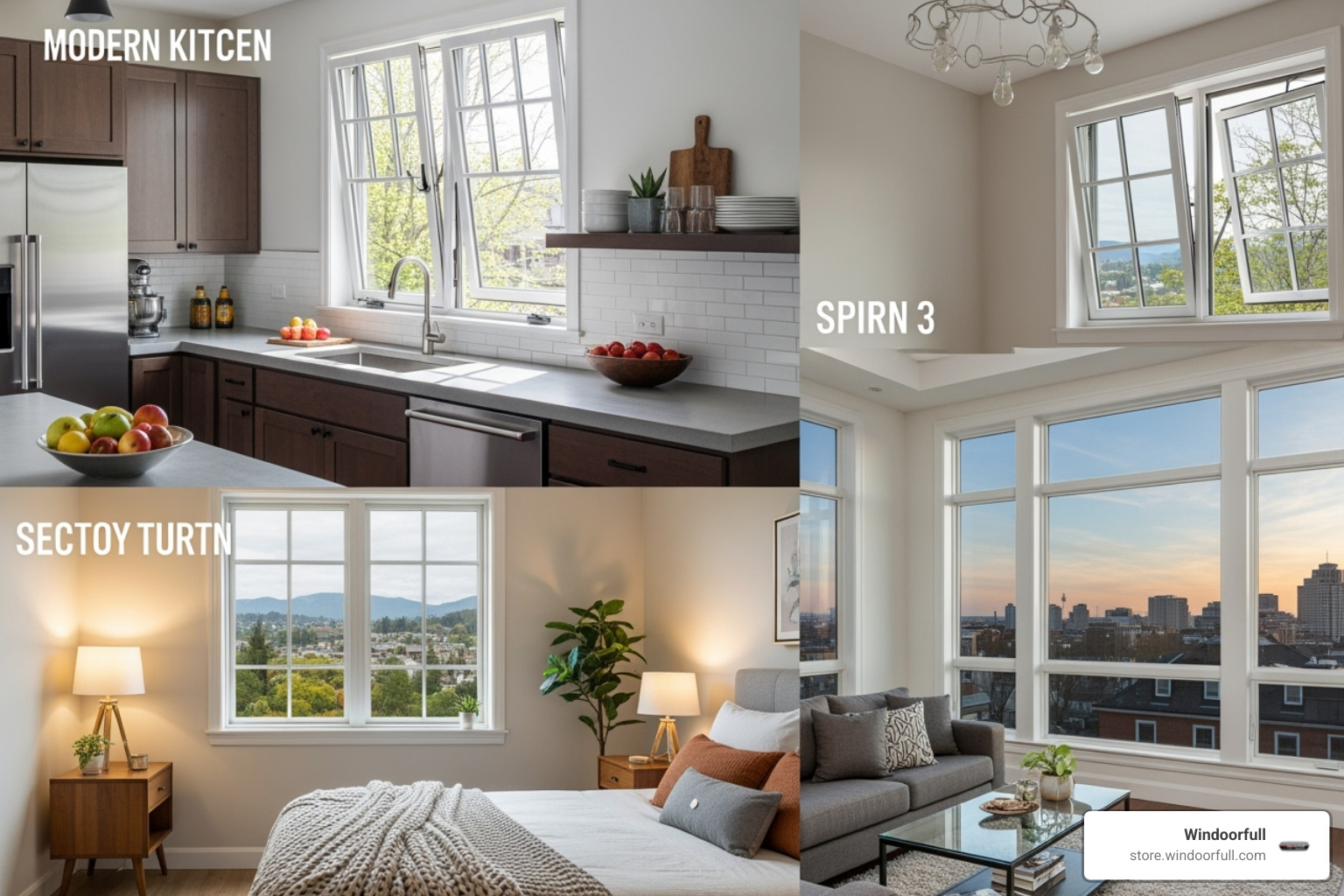
Their architectural flexibility is a key benefit. The unobstructed glass provides beautiful sightlines, and the sleek hardware adds a touch of European elegance that improves any design.
High-Quality Materials for Lasting Durability
Our windows are built to last, using high-performance uPVC construction and precision European hardware.
uPVC (Unplasticized Polyvinyl Chloride) is a sophisticated material engineered for durability. It resists moisture, temperature extremes, and UV damage, with a typical lifespan of 30-40 years with minimal maintenance. Unlike wood, it won't rot or warp, and unlike some metals, it won't corrode. Our frames are also steel-reinforced, making them 3-4 times stronger than standard construction.
European hardware is precision-engineered for smooth, reliable operation of the dual-action mechanism. The multi-point locks, hinges, and handles are built to last, ensuring consistent performance for decades. This combination results in windows that are virtually maintenance-free.
Aesthetic Choices and Custom Configurations
Tilt and Turn Windows offer a wide range of customization options to match your style:
- Frame Colors: Beyond classic white, we offer sleek black and other colors to suit contemporary or traditional designs.
- Woodgrain Finishes: Get the warm look of wood with the durability of uPVC. Realistic finishes like Antique Oak, Black Cherry, and European Walnut are available.
- Grids and Mullions: Integrate decorative grids to match architectural styles, from traditional Georgian patterns to clean, modern lines.
- Combinations: Pair Tilt and Turn Windows with fixed windows to maximize views while strategically placing operable sections for ventilation.
- French Doors: Extend the tilt-and-turn functionality to larger openings with French Tilt and Turn Doors, perfect for connecting indoor and outdoor spaces.
Common sizes range from small 20-inch square units to large configurations nearly five feet wide and eight feet tall, allowing for expansive glass walls with targeted ventilation.
Installation, Cost, and Maintenance
Upgrading to Tilt and Turn Windows is an exciting step, and at Windoorfull, we can guide you through the practical aspects of installation, cost, and care.
It might be time for new windows if you notice drafts, frame rot or deterioration, windows that stick, or condensation between glass panes. These issues, along with rising energy bills, are clear signs that your old windows are failing. Tilt and Turn Windows solve these problems with superior insulation, durable uPVC that won't rot, smooth European hardware, and energy efficiency that can cut utility costs by up to 30%.
We handle the professional installation to ensure a perfect, airtight seal. A full house installation typically takes just 1-2 days, with minimal disruption. While the initial investment is higher than for basic windows, the long-term value is substantial. Energy-efficient windows can increase your home's value by up to 10%, as modern buyers seek these features.
What Do Tilt and Turn Windows Cost?
The higher cost of Tilt and Turn Windows is due to their superior components. The sophisticated multi-point locking system, dual-action mechanism, and precision manufacturing required for a perfect seal all contribute to the price. Larger sizes and custom options also play a role.
Glazing choices like triple-glazing or Low-E coatings impact the price but dramatically improve performance. While the upfront cost is higher, the energy savings of up to 30% on heating and cooling over the window's 30-40 year lifespan often offset the initial difference. Many homeowners find the long-term savings make them a financially sound investment. For a detailed breakdown, see our guide: Tilt and Turn Windows: What's the Damage to Your Budget?.
Simple Cleaning and Maintenance
One of the most loved features of Tilt and Turn Windows is how easy they are to clean.
The "turn" function is a game-changer. The sash swings fully inward, allowing you to clean both sides of the glass from inside your home—no ladders or dangerous reaching required. A simple solution of vinegar and water is all you need. Avoid power washing, as it can damage the seals.
Frame maintenance is minimal thanks to uPVC, which won't rot, rust, or fade. An occasional wipe-down with soap and water is sufficient. The only regular task is occasional lubrication of the hardware to ensure the mechanism continues to operate smoothly for years to come. For more tips, see this guide on how to clean windows.
Frequently Asked Questions about Tilt and Turn Windows
At Windoorfull, we often hear the same thoughtful questions from homeowners considering an upgrade. Here are answers to the three most common inquiries about our European-engineered windows.
Are tilt and turn windows good for all climates?
Yes, Tilt and Turn Windows excel in all climates. Their superior insulation and airtight compression seal make them highly effective in both hot and cold environments. In hot climates, Low-E coatings block solar heat, reducing air conditioning costs. In cold climates, multi-chambered frames and triple-pane glazing prevent heat loss, keeping your home warm. The tilt function provides gentle ventilation in any weather without causing significant temperature swings.
Can tilt and turn windows be used as emergency exits (egress)?
Absolutely. This is a key safety feature. In the "turn" position, the window swings fully inward, creating a large, unobstructed opening that typically meets or exceeds building code requirements for emergency egress in bedrooms and other living spaces. The inward-opening design ensures the path is always clear, with no risk of being blocked by outdoor obstacles.
Are tilt and turn windows more expensive than other types?
Yes, the upfront cost is typically higher than for standard windows due to the sophisticated European hardware, precision engineering, and robust construction. However, it's important to consider the long-term value. These windows can reduce heating and cooling costs by up to 30% and increase your home's value by up to 10%. When you factor in the energy savings over their 30-40 year lifespan, plus benefits like superior security, soundproofing, and low maintenance, Tilt and Turn Windows often prove to be the more economical choice over time.
Conclusion
We've covered how Tilt and Turn Windows can revolutionize your home with the best of European engineering. They are more than just windows; they are a smart investment in your daily life and your home's future.
From versatile ventilation and superior security to top-tier energy efficiency and a sleek, modern design, these windows deliver benefits that traditional styles simply can't match. The added convenience of effortless cleaning and long-term durability makes them a truly intelligent choice.
At Windoorfull, we are committed to providing authentic European engineering at American-friendly prices. We believe everyone deserves a comfortable, secure, and energy-efficient home. For our local customers, pickup is available in Ozone Park, New York.
Ready to experience the difference? Learn more about why Tilt and Turn Windows are The Smart Choice for Modern Homes: Why Tilt and Turn Windows Belong in Your USA Home.
